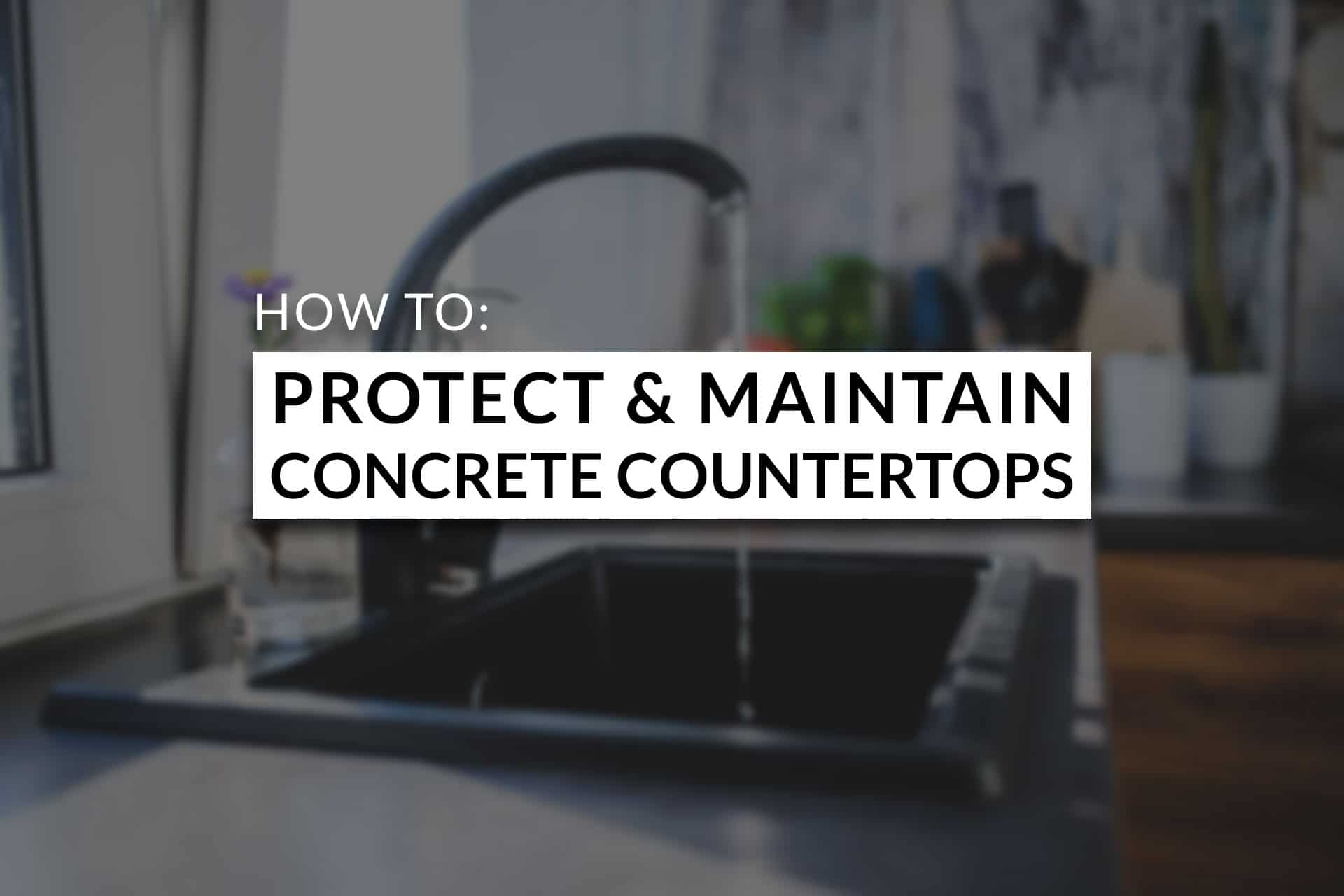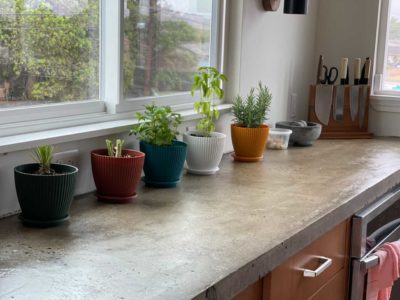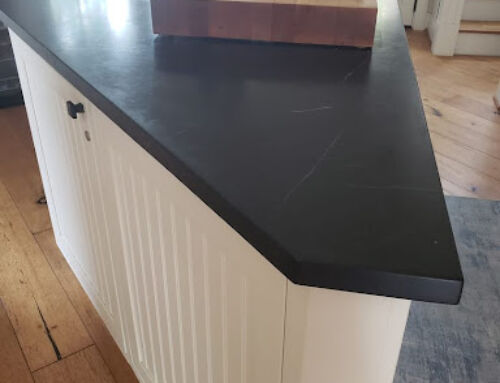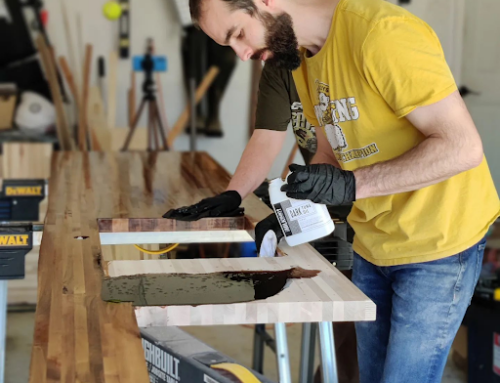
Many homeowners choose concrete countertops for their durability, but the truth is that no material is indestructible. An untreated working surface will crack over time, especially if you don’t seal them. They can also develop stains, scratches, dings and dents. While a sealing product may not prevent all of these issues, it can help minimize the impact to the appearance and function of your kitchen counters.
If you’re on the fence about installing a surface crafted from concrete, you’re in the right place. Scroll down to learn why concrete countertops are trending as well as how to seal and maintain them.
The Kitchen Counter Design Trend
Move over quartz and marble; the natural look of concrete countertops are here to steal the show. Joanna Gaines raves about the “timeless, industrial feel”, which pair well with her antique kitchen island. Famous couple, Jillian and Patrick Dempsey, also have kitchen surfaces constructed from concrete, and Pinterest has no shortage of beautiful images.
But why are they so popular now, and is this just a passing fad? Well, this particular trend might have staying power, especially when you consider these benefits:
- Variety of styles and colors
- Easy to customize
- Durable design
- Heat resistant
- Invisible seams
- Appearance evolves and improves over time
- Low maintenance
Depending on the other materials you’re considering, you may also find that creating a working surface from concrete is a budget-friendly option for your family.
Do Concrete Surfaces Have to Be Sealed?

Photo thanks to @marcortorreal on Instagram
You don’t have to seal your concrete products or working surface, but we certainly encourage it. Even those made from resilient concrete, are prone to wear and tear and definitely aren’t scratch-proof or stain-resistant no matter how careful you are in the kitchen. While you may not mind the occasional scratch or scrape, large cracks can majorly affect the appearance. Sealing helps keep your counters scratch resistant while also protecting them from damage and enhancing their sheen.
Concrete is a porous surface, which means it retains moisture. Because of this, your working surface may absorb spilled food, oil or liquid if you don’t seal them. Unsealed surfaces stain easily when they’re made from porous material, and may even develop mold or mildew over time. Using the right sealer offers stain resistance and heat resistance for your concrete countertop surface or table tops. You won’t have to worry about red wine or lemon juice spills permanently staining your countertops anymore.
What to Seal The Kitchen Countertop With
Many homeowners and contractors rely on Soapstone Sealer and Wood Wax when sealing concrete countertops. This concrete countertop sealer also works well on wood, marble, slate and granite surfaces. Another great option is Pure Tung Oil.
You may also have luck with silicates, siliconates, epoxies, urethanes and acrylics. Unfortunately, there are downfalls associated with many sealant types because concrete is notoriously difficult to seal properly. Many sealers only address a couple of issues, such as scratch resistance or heat protection, instead of providing complete coverage.
Pros of Soapstone Sealer and Wood Wax
If you’re considering Soapstone Sealer and Wood Wax, you may be wondering why you should choose it over other sealants. Here are some benefits of this versatile product:
- Made from all natural ingredients
- Not a petroleum-based product
- No volatile organic chemicals (VOCs) added
- No added fragrances
- Made using food-safe materials
- Contains walnut oil, which will polymerize or cure rather than go rancid when air hits
- Requires less reapplication than mineral oil
Cons of Soapstone Sealer and Wood Wax
As with any product, there are some cons associated with Soapstone Sealer and Wood Wax, though every sealant has its downfalls. For starters, expect to wait 5 to 7 days for a hard dry and 15 to 30 days for the solution to cure. As we state in our video tutorial dedicated to FAQs about Soapstone Sealer and Wood Wax, it’s important to keep water and heavy objects, such as mixing bowls and microwaves, off the surface during the first week.
Another potential downfall is that our sealer contains walnut oil, which may trigger an allergic reaction in some individuals. However, our walnut oil is heated, which may help make it more allergy friendly. Also, we have had zero reports of allergic reactions since the product was launched more than 10 years ago, though it’s important to note that a reaction — while rare — is possible.
Tips and Mistakes to Avoid
The wrong sealer can damage your kitchen counter, so it’s essential that you choose the best one for your needs. Here are a few mistakes to watch out for when you are sealing.
Mistake 1: Choosing the Wrong Sealant
Searching for the ideal sealer can be understandably overwhelming. There are so many brands and options, each of which claim to do something different. Before you choose a sealing product, consider what you want and need from a sealant, and then choose one based on these factors.
Mistake 2: Applying Sealant the Wrong Way
You can’t just glob on some sealant and hope for the best. Each sealant has its own unique instructions, which is why we detail how to use Soapstone Sealer and Wood Wax in our video tutorial. We can’t speak for other brands, but we can give you a quick rundown of how to use our sealer.
Start by removing mineral oil from the surface if you have any on there. Mineral oil is a nondrying oil, and you can’t mix a drying oil like Soapstone Sealer and Wood Wax with a nondrying oil. Use a thinner, such as paint thinner or turpentine, to get the mineral oil off the working surface.
After that, rub a thin layer of Soapstone Sealer and Wood Wax onto the surface. We like to use an old sock, but you can also use a soft cloth. Leave the layer on for at least 15 minutes but no longer than 30 minutes.
Remove excess wax with an old T-shirt or a lint-free cloth. Press hard if needed, because excess wax will affect the overall appearance.
Watch out for water, especially during the first 24 hours. If water gets on the working surface during the curing process, it can get trapped beneath the surface. Expect to wait approximately one week for a hard dry and up to 30 days for a full cure. We recommend doing this right before you leave for vacation so you don’t accidentally use your working surface while you’re waiting that first week out.
Mistake 3: Getting Sealant on Your Backsplash or Walls
Concrete sealant is made for concrete, not vinyl or painted surfaces. If you get sealant on your walls, it may change the hue of the paint or leave behind oily marks.
How to Maintain Kitchen Surfaces for Lasting Beauty
Soapstone Sealer and Wood Wax can last for years, but over time, you may need to reapply it. You may notice some worn spots in areas that get frequent action, such as the spot where you mix dough or prep veggies.
When it’s time for reapplication, you may not need to treat the entire surface. Apply the solution to worn areas following the original directions, and see if that solves the cosmetic concern. If not, go ahead and redo the whole surface, and then repeat the drying and curing process.
Concrete countertops are a low-maintenance option for your kitchen because they’re durable and easy to clean, and a sealant helps enhance these qualities by protecting the working surface from damage. Questions about Real Milk Paint products? Fill out our contact form or call 800-339-9748 for more info!



